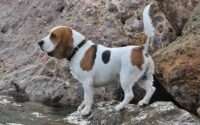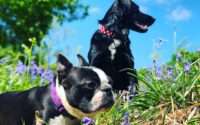Akita Inu vs Shiba Inu: Which Japanese Breed Is Right for You?
You’re ready to welcome a furry friend into your life, but you’re faced with a tough decision: should you go for the majestic Akita Inu or the charming Shiba Inu? It’s a dilemma many dog lovers encounter, and we’re here to help you navigate through it.
In this comprehensive guide, we’ll dive deep into the world of these two Japanese breeds, shedding light on their distinct characteristics, temperaments, and needs. By the end, you’ll be equipped with the knowledge to make the best choice for you and your lifestyle.
History and Origin
To understand the essence of the Akita Inu and the Shiba Inu, we must embark on a journey back in time to uncover their rich histories and origins.
Akita Inu: With roots tracing back to ancient Japan, the Akita Inu holds a revered status as a symbol of strength, loyalty, and nobility. Originally bred for hunting and guarding purposes, these majestic canines were esteemed companions of Japanese royalty and aristocrats. Their lineage is steeped in tradition, embodying the essence of Japanese heritage and culture.
Shiba Inu: The Shiba Inu, on the other hand, emerges from a similar backdrop of ancient Japan but with a distinct role as a versatile hunting companion. Their spirited personality and fox-like appearance have earned them a special place in Japanese folklore and culture. Despite their small stature, Shiba Inus are known for their courage, agility, and independent spirit, traits that have endeared them to dog enthusiasts worldwide.
Physical Characteristics
Now, let’s dive into the visual allure of these two captivating breeds—the Akita Inu and the Shiba Inu. Each possesses distinct physical characteristics that set them apart and contribute to their undeniable charm.
Akita Inu: Picture a majestic creature with a powerful build and a thick double coat exuding an aura of strength and dignity. The Akita’s imposing stature is complemented by a broad head, small eyes that radiate intelligence, and a signature curled tail that adds to its regal appearance. With a range of coat colors and patterns to choose from, including brindle, red, and white, each Akita is a work of art in its own right.
Akita Inus typically range in height from 24 to 28 inches at the shoulder and weigh between 70 to 130 pounds, with males generally larger than females. In terms of lifespan, Akita Inus typically live between 10 to 13 years, depending on various factors such as genetics, diet, and healthcare.
Shiba Inu: In contrast, the Shiba Inu embodies a more compact and fox-like aesthetic, with a plush double coat that begs to be petted. Their triangular ears, dark almond-shaped eyes, and curled tail give them an irresistibly cute yet mischievous expression. Shiba Inus come in a variety of coat colors, including red, sesame, and black and tan, each accentuating their playful and spirited demeanor.
Shiba Inus typically stand between 13.5 to 16.5 inches at the shoulder and weigh approximately 17 to 23 pounds, making them a more manageable size for many households. In terms of lifespan, Shiba Inus generally live between 12 to 15 years, with proper care and nutrition contributing to their longevity.
Temperament and Personality
Beyond their stunning exteriors, the Akita Inu and Shiba Inu possess unique temperaments and personalities that endear them to their human companions.
Akita Inu: Known for their unwavering loyalty and protective nature, Akita Inus are fiercely devoted to their families. While they may appear aloof to strangers, they form deep bonds with their loved ones and will go to great lengths to protect them. However, their independent streak can present training challenges, requiring patience and consistency to channel their innate intelligence and obedience.
Shiba Inu: Don’t let their small size fool you—Shiba Inus are brimming with personality and confidence. With a playful and spirited disposition, they approach life with an adventurous spirit and a hint of mischief. While they may not be as overtly affectionate as some breeds, their loyalty to their families runs deep. Training a Shiba Inu requires a delicate balance of firmness and positive reinforcement, as they have a tendency to assert their independence.
Exercise and Activity Needs
Now, let’s talk about keeping these spirited breeds happy and healthy through regular exercise and activity.
Akita Inu: Despite their imposing size, Akita Inus have moderate exercise requirements and prefer short bursts of activity interspersed with plenty of rest.
Engaging them in mentally stimulating activities such as puzzle toys or obedience training sessions can help keep their sharp minds engaged. While they may not be the most enthusiastic participants in high-energy games, they enjoy leisurely walks and calm outdoor outings with their human companions.
Shiba Inu: With boundless energy and a playful demeanor, Shiba Inus thrive on daily exercise and mental stimulation. Regular walks, interactive games, and opportunities for exploration are essential for keeping them physically and mentally stimulated.
Be prepared for their keen hunting instincts to kick in during outdoor adventures, as they have a knack for sniffing out exciting scents and chasing after small prey. Providing ample opportunities for exercise and enrichment will help prevent boredom and ensure a happy and well-adjusted Shiba Inu.
Grooming and Maintenance
Keeping your furry friend looking and feeling their best requires attention to grooming and maintenance.
Akita Inu: Despite their thick double coat, Akita Inus have moderate grooming needs. Regular brushing helps to remove loose hair and prevent mats and tangles, especially during seasonal shedding periods.
Occasional baths with a gentle dog shampoo help keep their coat clean and healthy, while routine nail trimming and dental care are essential for overall hygiene. Paying attention to their ears and eyes for signs of infection or irritation ensures their well-being and comfort.
Shiba Inu: With their plush double coat, Shiba Inus require regular grooming to keep their fur looking pristine. Brushing at least a few times a week helps to remove loose hair and minimize shedding, especially during seasonal changes.
Bathing should be done as needed, using a mild dog shampoo to avoid drying out their skin. Pay special attention to their ears, teeth, and nails, as these areas require regular cleaning and maintenance to prevent issues. With proper grooming and care, your Shiba Inu will maintain their signature fluffy appearance and stay happy and healthy for years to come.
Health Considerations
Ensuring the well-being of your furry companion means staying informed about potential health considerations and taking proactive measures to address them.
Akita Inu: Like all breeds, Akita Inus may be prone to certain health conditions, including hip dysplasia and progressive retinal atrophy (PRA). Regular veterinary check-ups and health screenings are essential for early detection and treatment of these conditions.
Maintaining a healthy diet, providing regular exercise, and monitoring their weight can help mitigate the risk of obesity-related issues. By staying vigilant and addressing any health concerns promptly, you can help your Akita Inu live a long, happy, and healthy life.
Shiba Inu: Shiba Inus are generally healthy dogs, but they may be susceptible to certain health issues, such as patellar luxation and allergies. Regular veterinary care, including vaccinations and parasite prevention, is crucial for maintaining their health and well-being.
Providing a balanced diet, regular exercise, and proper grooming can help support their overall health and immune system. As with any breed, being proactive about their health and addressing any concerns promptly can help ensure a long and fulfilling life for your Shiba Inu.
Living Environment and Suitability
Creating a nurturing environment that meets your dog’s needs is essential for their happiness and well-being.
Akita Inu: While their imposing size may suggest otherwise, Akita Inus can adapt well to various living environments, including apartments and houses. However, they thrive in homes with ample space to move around and a secure outdoor area for exercise and play.
Their protective nature makes them well-suited for families, but early socialization is crucial to ensure they feel comfortable around children and other pets. Additionally, their thick double coat provides insulation against cold weather, but they may struggle in hot climates, so it’s essential to provide shade and plenty of water during warmer months.
Shiba Inu: With their smaller size and spirited personality, Shiba Inus are well-suited for apartment living, provided they receive plenty of exercise and mental stimulation. They enjoy having access to outdoor space for play and exploration but can adapt to urban environments with regular walks and activities.
Shiba Inus are generally good with children and other pets when properly socialized, but supervision is always recommended, especially with smaller animals. Their thick double coat provides insulation against cold weather, but they may require extra precautions in extreme temperatures to prevent overheating.
Training and Socialization
Setting your furry friend up for success involves implementing effective training and socialization strategies from an early age.
Akita Inu: Training an Akita Inu requires patience, consistency, and firm yet gentle guidance. Early socialization is essential to ensure they are comfortable and well-behaved around people and other animals.
Positive reinforcement techniques, such as treats and praise, can help motivate them during training sessions. Establishing yourself as a calm and confident leader is key to earning their respect and cooperation. With proper training and socialization, your Akita Inu will grow into a well-mannered and balanced companion.
Shiba Inu: Training a Shiba Inu can be an exercise in patience, as they are known for their independent and stubborn nature. Positive reinforcement techniques, such as clicker training and rewards-based methods, work best with this breed.
Consistency and firmness are essential, but it’s important to avoid harsh or punitive methods, as they can backfire and lead to resistance. Early socialization is crucial to help your Shiba Inu develop good manners and feel confident in various situations. With patience and persistence, you can help your Shiba Inu become a well-behaved and obedient companion.
Common Myths and Misconceptions
Separating fact from fiction is essential when it comes to understanding these beloved breeds and their unique traits.
- Myth: Akita Inus are inherently aggressive.
Reality: While Akita Inus are known for their protective nature, they are not inherently aggressive. With proper socialization and training, they can be friendly and well-behaved companions. Like any breed, individual temperament varies, but aggression is not a defining characteristic of the breed. - Myth: Shiba Inus are difficult to train.
Reality: Shiba Inus are intelligent and independent, which can make training challenging at times. However, with patience, consistency, and positive reinforcement techniques, they can be trained to be obedient and well-mannered. It’s essential to understand their unique personality traits and tailor your training approach accordingly.
By dispelling common myths and misconceptions, we can gain a better understanding of these remarkable breeds and appreciate them for the wonderful companions they are.
Conclusion
As we reach the end of our journey exploring the world of Akita Inus and Shiba Inus, one thing becomes clear: both breeds offer unique qualities and characteristics that make them wonderful companions. Whether you’re drawn to the Akita’s noble presence and unwavering loyalty or the Shiba’s spirited personality and playful antics, there’s a lot to love about these remarkable breeds.
Before making a decision, it’s essential to consider your lifestyle, preferences, and the specific needs of each breed. Take the time to research and learn as much as you can about Akita Inus and Shiba Inus, and don’t hesitate to reach out to breed experts or reputable breeders for guidance.
Remember, bringing a furry friend into your life is a commitment that requires love, patience, and dedication. Whichever breed you choose, the bond you’ll share with your canine companion will be nothing short of extraordinary.
Frequently Asked Questions
What were Akita Inus and Shiba Inus originally bred for?
Shiba Inus were bred to hunt small game, while Akitas were originally used for hunting larger animals and also served as guard dogs.
How much grooming do Akita Inus and Shiba Inus require?
Both breeds have double coats and shed seasonally. Regular brushing is required to manage shedding. Shiba Inus are known for their cat-like grooming habits, while Akitas may require more frequent brushing due to their larger size.
Are Akita Inus and Shiba Inus prone to any specific health issues?
Both breeds can be prone to hip dysplasia. Akita Inus may also be at risk for autoimmune diseases, while Shiba Inus can sometimes suffer from allergies and glaucoma.
How much exercise do Akita Inus and Shiba Inus need?
Both breeds are active and require regular exercise. Shiba Inus need daily walks and playtime, while Akitas require more intensive exercise to match their larger size and energy levels.
Can Akita Inus and Shiba Inus live in apartments?
Shiba Inus are better suited for apartment living due to their smaller size, but they still require plenty of exercise. Akita Inus, being larger, may need more space and are better suited for homes with yards.
What is the main size difference between an Akita Inu and a Shiba Inu?
The Akita Inu is significantly larger than the Shiba Inu. Akitas can weigh as much as a hundred pounds or more, while Shiba Inus are much smaller, typically no more than 25 lbs.
Are Akita Inus and Shiba Inus easy to train?
Both breeds are known for their intelligence, but they can be stubborn and independent, which might make training a challenge. Shiba Inus, in particular, are not famous for their trainability.
Do Akita Inus and Shiba Inus have similar temperaments?
Both breeds can be independent and strong-willed. However, Akita Inus are known to be more aloof and reserved, especially with strangers, while Shiba Inus can be feisty and spirited.
Are Akita Inus or Shiba Inus better with children?
Shiba Inus can be good with children if they are raised together, but due to their smaller size and spirited nature, supervision is advised. Akita Inus are protective and may be better with older children due to their size and strength.
How long do Akita Inus and Shiba Inus typically live?
Shiba Inus have a lifespan of approximately 12 to 15 years, while Akita Inus generally live between 10 to 13 years.
What is the difference in the coat colors of Akita Inus and Shiba Inus?
Shiba Inus typically come in red, sesame, black and tan, or cream. Akita Inus have a broader range of colors including white, brindle, and pinto patterns.
Are Akita Inus or Shiba Inus more social with other dogs?
Both breeds can be territorial and may not always get along with other dogs, especially of the same sex. Early socialization is key for both breeds to promote good behavior around other dogs.




